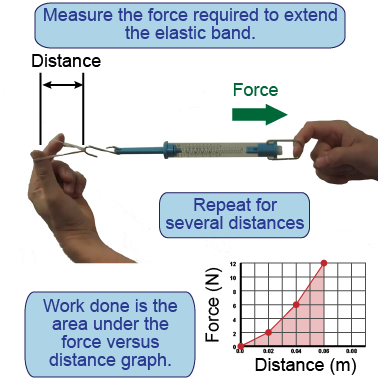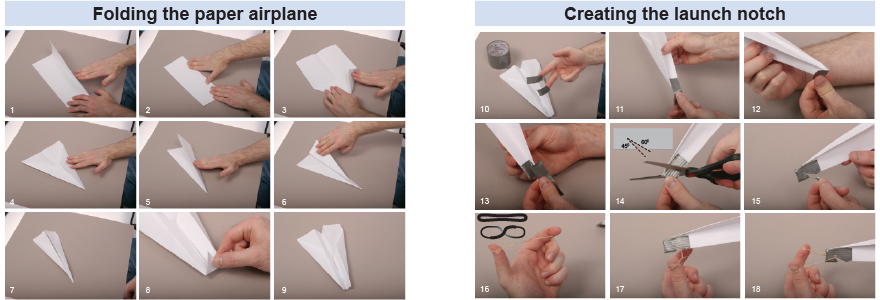|
| Essential questions | | How is the work done on a system related to its change in energy?
How is the efficiency of a system calculated? | |
|
Have you ever folded a paper airplane and thrown it? Have you launched it with an elastic band? A paper airplane and elastic band form a system that provides insight into the relationship between work and energy. When the elastic band is pulled back, it stores elastic potential energy. When it is released, the elastic band does work on the airplane to launch it. You will compare the energy stored in the elastic band to the kinetic energy of the launched airplane. 
|
Part 1: Measure work done to extend an elastic band

- Hold the elastic band between two fingers while pulling on the band with one end of a spring scale. Measure the distance the band is stretched.
- Measure the force to stretch the elastic band four different distances. Tabulate your results.
- Make a line graph of force versus distance. Calculate the work required to stretch the elastic band using the area under the curve of your graph.
- Why does the area under the curve of a force versus distance graph represent the work done to stretch the band?
- What is the total work done to stretch the elastic band for each distance you measured?
- What is the theoretical maximum velocity for the airplane if it is launched by stretching the band the largest distance you measured?

 |
Constructing the paper airplane


|
Part 2: Estimate the velocity of the launched airplane
The work done by the elastic band on the paper airplane is W = ΔEk = ½mv2. To calculate the change in kinetic energy of the paper airplane, its velocity must be measured or estimated. - Design a procedure to measure the airplane’s initial velocity when it is launched. What variables will you measure? What equipment and/or technology is appropriate?
- Using your procedure, make the measurements and calculations needed to estimate the airplane’s velocity. Ask yourself whether this answer is reasonable.
- Calculate the efficiency of the rubber band system in launching the paper airplane. Do this by comparing the stored elastic potential energy of the rubber band you derived in Part 1 with the initial kinetic energy of the airplane.

|
- Describe your procedure to measure the plane’s launch velocity.
- In the investigative procedure you designed, what are the independent, dependent, and controlled variables?
- What are the airplane’s launch velocity and kinetic energy?
- How efficient is the elastic band system? Explain the significance of the value you obtain.
- What accuracy in velocity is required to produce a ±0.1 measurement of the efficiency?

|
|
You may find this interactive equation useful in this investigation. This interactive equation calculates the conservation of energy for a falling ball that has an initial velocity of zero.
|

